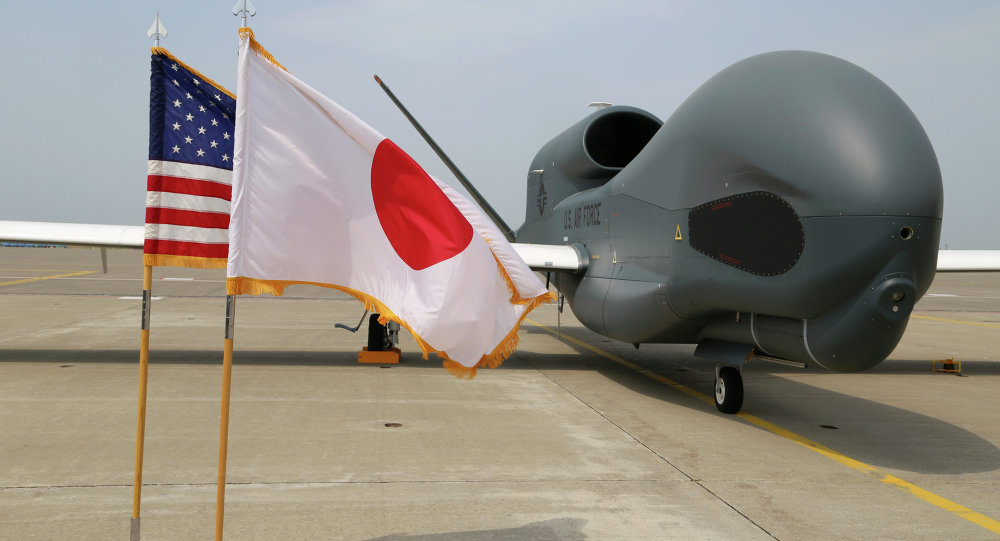The following is the most recent update to the ongoing chronicle of the global drone arms race.
It has been predicted that the development of drone surveillance by the U.S. would spark a global race to develop new drone capabilities, leading to a potentially dystopian future of drone wars where combat and even assassinations can be performed by fleets of insect-like microbots. The Washington Post reported in July, 2011:
More than 50 countries have purchased surveillance drones, and many have started in-country development programs for armed versions because no nation is exporting weaponized drones beyond a handful of sales between the United States and its closest allies. (Source)
The number of countries possessing surveillance drones has now risen toward 90, plus the United Nations itself has launched its own fleet. Armed drones are also proliferating rapidly with at least 20 countries believed to have unmanned weaponized vehicles. Japan is the latest to go full-steam ahead in an effort to keep up – so much so that they actually have rewritten their constitution to ensure more militaristic endeavors.
As you will see from the various updates below, I have been chronicling the global drone arms race in its various forms for quite some time. We are now reaching the threshold where the race to acquire drones is about to transform into who has the most, who has the most lethal, and who can properly incorporate autonomous functions to build the next generation of robotic warfare and dominate the planet.
Defense One is reporting a startling new reality in Japan: the loosening of their constitution as a means to permit the deployment of drones outside its borders. It comes at a particularly troubling time, as tensions rise with China over resources in the area of the Senkaku Islands.
A key long-term goal for Japan’s booming drone program is to use these military UAVs abroad to protect the country’s interests, said the IHS Jane’s senior analyst. However, until last month, this would have been illegal due to Article 9 of the nation’s pacifist constitution, which explicitly prohibits belligerence.
[…]
In June, (Prime Minister) Abe granted the nation’s self-defense forces more power when he gutted Article 9, the so-called “peace clause.” Through a cabinet decision, Abe re-interpreted the article to allow greater use of military force to defend other countries. In doing so, he bypassed parliament and the typical requirement for a referendum for any change to the constitution. (emphasis added)
Did anyone hear about this from America’s corporate media? Apparently, it didn’t go over well in Japan:
Hundreds of thousands of Japanese citizens protested outside the prime minister’s official residence, while a man on a bridge in central Tokyo set himself on fire to demonstrate against the move. The Japanese media blasted the decision. Abe ignored the criticisms and plowed ahead. In a press conference to present the changes, he announced that the time had come for a re-interpretation of the law. He said North Korea’s nuclear missile program and China’s military expansion in the region justified the move.
Sounds like dictatorial action being taken in a supposed democracy … with the full support of the U.S. government.
A veteran Japanese politician even warned that the country’s re-armament looked like “a kind of pre-war revival.” The United States has aided Tokyo in its efforts to re-arm, deploying two unarmed Global Hawk long-range surveillance drones in May to a base in Northern Japan, which infuriated both China and North Korea.
Japan certainly has come a long way from the novelty beach ball drone that began this chronicle more than two years ago. This new willingness to shed their modern-day pacifism at such a contentious political time across the planet could quickly ignite into a major conflict.
As you read through the updates below, where do think this drone race is likely to lead?
Please read the full article from Defense One here:
_______________________________________________________________________
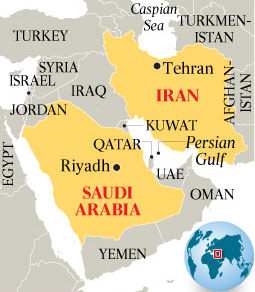 |
| image source |
Iran and Saudi Arabia Claim Success Joining the Global Drone Arms Race
Saudi Arabia’s new claims to have bought a drone fleet from China that would rival America’s Predator drones is somewhat puzzling due to the fact that Saudi Arabia has been a close partner since at least 2011 in US-led drone strikes in Yemen operating from a CIA base within Saudi borders.
Moreover, it was reported more than a year ago that Saudi Arabia likely purchased an armed drone from South Africa, supposedly because they couldn’t acquire one from the U.S. or China. The video below is a good discussion of what might be behind the desire for Saudi Arabia to possess armed drones, as well as the political reasons for secrecy about various allegiances.
Iran has long been suspected of possessing some form of drone tech, but is finally going on the record to claim that it has successfully copied a Lockheed Martin Sentinel RQ-170 drone that crashed or was downed in Iran sometime in 2011.
“Our engineers succeeded in breaking the drone’s secrets and copying them. It will soon take a test flight,” an officer said in the footage broadcast on Iranian TV. “This drone is very important for reconnaissance missions,” Khamenei said as he viewed the drone.
The original Sentinel RQ-170 unmanned aerial vehicle (UAV) was used in US covert operations in Afghanistan from 2005 until 2007, according to the report. One of the important features of the drone is that it is hard to detect with long range radar due to its special stealth coating, making it visible only from a distance of around 40 kilometers.
In December 2011, Iran claimed to have captured it flying over Iran, which the US military acknowledged. Washington filed a formal request for Iran to return the UAV, which Iran rejected instead demanded an apology for US intelligence operation over its territory.
Since then Iran has also hunted down two more types of UAVs. Two RQ-11s and at least one ScanEagle that had penetrated Iranian airspace from the Persian Gulf.
[…]
“All the memories and computer systems of this plane have been decoded and some good news will be announced in the near future not just about the RQ-170 and the optimizations that our forces have done on the reversed engineered model of this drone, but also in area of other important defense achievements,” Hossein Salami, the lieutenant commander general of Iran’s Army of the Guardians of the Islamic Revolution said at the time.
Iran earlier managed to present a functional copycat model of the US ScanEagle to a Russian military delegation visiting Tehran last October. Before that, in February last year, Tehran demonstrated images of a ScanEagle UAV drone production line, revealing that this low-cost, high endurance drone would provide low-altitude reconnaissance for the Iranian military. (Source)
While all of this might be true from a limited perspective, it is also worth noting that on the larger grand chessboard there is nothing that the military-industrial complex would love more than a truly threatening Iran and escalated regional conflict. The nuclear issue has been beaten to death with every provocation offered by the West, but Iran has yet to take that particular bait.
Perhaps a “downed-and-copied” sophisticated weaponized drone will finally provide a more plausible reason to further increase proliferation of even newer versions to stay ahead of the #1 enemy of Israel and the United States – all the while both countries already possessing both nuclear weapons and being avid developers of the latest in drone tech.
It will be worth paying attention to how the propaganda develops from here.
______________________________________________________________
“Within Ten Years” – All Countries Will Have Weaponized Drones: Report
 |
| image source: Defense One |
The number of countries preparing armed drones is also rising – 23 by RAND corporation’s count. Most significantly, China successfully tested their first combat stealth drone, the U.S. tested a new stealth drone at Area 51 and England released its Taranis £185 million stealth bomber.
This race has only one endgame according to a new report by Defense One: planet-wide weaponized drones, most likely autonomous.
Defense One is a leading defense and tech news outlet that analyzes trends in national security. Their conclusions from a recent report are worth examining, as they state unequivocally “Every Country Will Have Armed Drones Within Ten Years.”
Armed aerial drones will be used for targeted killings, terrorism and the government suppression of civil unrest. What’s worse, say experts, it’s too late for the United States to do anything about it. (emphasis added).
As I’ve stated many times, this is the classic problem-reaction-solution that we face across the spectrum, but most obviously with drones. Who invented them and who now has the “problem”?
The above quote also implies that the U.S. would never be one of the countries who itself would use weaponized drones for the suppression of civil unrest inside its own borders.
So, we have to look ahead to what type of world will be built upon these “solutions.” Part of Defense One’s analysis incorporates statements from the RAND corporation, which immediately should set off every available red flag. Naturally, the implication is that the solution is for the U.S. to take the lead and begin equipping their allies, as well as restructuring the international restrictions applying to drone tech and proliferation.
“If France had possessed and used armed UAVs…when it intervened in Mali to fight the jihadist insurgency Ansar Dine – or if the United States had operated them in support or otherwise passed on its capabilities – France would have been helped considerably. Ansar Dine has no air defenses to counter such aUAV threat,” note the authors of the RAND report.
In his paper, Brannan (senior fellow at the Center for Strategic and International Studies’ International Security Program,) makes the same point more forcefully. “In the midst of this growing global interest, the United States has chosen to indefinitely put on hold sales of its most capable [unmanned aerial system] to many of its allies and partners, which has led these countries to seek other suppliers or to begin efforts to indigenously produce the systems,” he writes. “Continued indecision by the United States regarding export of this technology will not prevent the spread of these systems.”
The Missile Technology Control Regime, or MTCR, is probably the most important piece of international policy that limits the exchange of drones and is a big reason why more countries don’t have weaponized drone technology. But China never signed onto it. The best way to insure that U.S. armed drones and those of our allies can operate together is to reconsider the way MTCR should apply to drones, Brannen writes.
So the solution is more proliferation. And the military-industrial complex gives another wink.
Sadly, after reading through the full article above, as well as the linked material therein, one must agree that weaponized drones are here to stay … and for one reason only: that it was the plan all along.
For the condensed version of the proof of inevitability, here is a video showing the projected drone battlefield in 2017. The only remaining question is what we can we do about this. Please leave your suggestions in the comment section below.
All previous developments are detailed in updates below.
______________________________________________________
The Global Drone Arms Race Is Becoming Autonomous: Scientist
 |
| image source |
The global drone arms race is still human-driven. While some of the systems themselves are becoming autonomous, one Artificial Intelligence (A.I.) scientist is issuing a strong caution about how far we should permit these systems to develop, as he believes that we could be on the cusp of losing full control.
In an echo of the caution issued by The Centre for the Study of Existential Risk in Cambridge, England, A.I. researcher and creator of the think tank Self-Aware Systems, Steve Omohundro, is becoming increasingly worried that advancements in A.I. coupled with military systems of automated war could theoretically move us into a “terminator drone” scenario.
The abstract of Steve Omohundro’s full study titled “Autonomous technology and the greater human good” appears in the latest Journal of Experimental & Theoretical Artificial Intelligence. It begins:
Military and economic pressures are driving the rapid development of autonomous systems. We show that these systems are likely to behave in anti-social and harmful ways unless they are very carefully designed.
He goes on to say that these systems are “imminent.”
Cambridge University officially launched their “Terminator” study program in November of last year and concluded that within 10 years robots would outnumber their human counterparts on the battlefield and there was indeed a possibility of becoming “anti-social and harmful.”
The concern is such that major international human rights groups have launched a campaign to stop the runaway development of robots for war.
Steve Omohundro highlights his own concern with a simple metaphor using the game of chess:
When roboticists are asked by nervous onlookers about safety, a common answer is ‘We can always unplug it!’ But imagine this outcome from the chess robot’s point of view. A future in which it is unplugged is a future in which it cannot play or win any games of chess.
He discusses the “rational machine” and what might happen in the first stage of evolution as systems gain full awareness. We only have to look at other primitive systems to understand the implications:
Harmful systems might at first appear to be harder to design or less powerful than safe systems. Unfortunately, the opposite is the case.
If imbued solely with a sense of self-preservation, as in the previous example of being removed from the chess game, they could exhibit a range of emotions, including anger and aggression. This could manifest in the following ways:
- Self-protection.
- Resource acquisition, through cyber theft, manipulation or domination.
- Improved efficiency, through alternative utilization of resources.
- Self-improvement, such as removing design constraints if doing so is deemed advantageous.
 If it seems outlandish that robot evolution could take place outside of human-directed parameters, there is already an attempt to give robots a “cloud brain” where robots can communicate with one another via a separate Internet. It has been dubbed the “Wikimedia for Robots.” While there is still no evidence that this could produce a type of de facto breakaway race of intelligent, autonomous robots – let alone the killer variety – an increasing number of researchers like Omohundro who are in the field are beginning to ask more probing questions.
If it seems outlandish that robot evolution could take place outside of human-directed parameters, there is already an attempt to give robots a “cloud brain” where robots can communicate with one another via a separate Internet. It has been dubbed the “Wikimedia for Robots.” While there is still no evidence that this could produce a type of de facto breakaway race of intelligent, autonomous robots – let alone the killer variety – an increasing number of researchers like Omohundro who are in the field are beginning to ask more probing questions.
While futurists such as Ray Kurzweil, a director of engineering at Google, tend to discuss a transcendental age of Spiritual Machines where humans only benefit from their own enhanced intelligence as well as the coming super A.I, the opposite reality should be equally – if not more strongly – considered. This wave of new technology is a fundamental transformation, not simply a new gadget that can be upgraded or phased out.
Other prominent names are backing up the significance of Omohundro’s discussion:
The study is echoed by new calls into examining the effects of super-intelligent artificial intelligence recently published by Stephen Hawking, Max Tegmark and others. They write, “although we are facing potentially the best or worst thing ever to happen to humanity, little serious research is devoted to these issues outside small non-profit institutes such as the Cambridge Center for Existential Risk, the Future of Humanity Institute, the Machine Intelligence Research Institute, and the Future of Life Institute.” (emphasis added)
The fact that most of the warnings about runaway Artificial Intelligence and Terminator Robots are coming from non-profit institutes; and nearly all of the wondrous platitudes about the technology making humanity even greater are coming from those with corporate interests to promote, should be among the greatest reasons to develop a serious concern for this particular version of the future.
You can find the full study here:
http://www.tandfonline.com/doi/full/10.1080/0952813X.2014.895111%20#.U1WDJfldU-V
Source:
http://www.33rdsquare.com/2014/04/steve-omohundro-urges-preventing.html
____________________________________________________________________________
“Taranis” Stealth Bomber Keeps England In The Drone Arms Race
 |
| War profiteers unite to build the latest stealth drone bomber – Taranis |
Perhaps to keep up with an announcement that the U.S. Air Force revealed testing a “top secret” stealth drone at Area 51, England has taken the lead by announcing that their own large stealth drone known as Taranis is now ready for action, seen in the video below.
Taranis was actually uncovered in 2010 as a £143 million project of BAE Systems that was initiated as far back as 2006 – a cost that has now escalated to £185 million, according to BAE’s website. At the time, it was announced that test flights would begin in 2011. This “Inspiration for a Nation” certainly conveys its intentions as it’s named after the Celtic god of thunder – we should expect more shock and awe to be on the way.
With a 10-meter wingspan, the aircraft is larger than you might expect for an unmanned vehicle; the logistics of both stealth and long-range flight push the design toward a large, mostly flat-ish belly and wings. While the building material is not currently known (and won’t be for many years) it likely incorporates specially light- and radar-deadening materials to weigh in, as it does, at just eight tonnes. With a budget of more than $300 million and more than a million man-hours invested, Taranis is a major part of the UK’s overall strategy for evolving its military in the coming decade. The country has already identified drones as one of the drivers of its next-generation fighting forces, and stealth drones are a necessary component of that push. (Source)
First test flight footage:
And here is the official promo video from BAE Systems calling Taranis “The Future of Aviation Technology.” Comforting.
The race is on to capitalize on the surge in the drone market around the world. You can read about that history in updates below. BAE systems states on its website that this new development actually puts England at #1 for the time being:
The findings from the aircraft’s test flights show that the UK has developed a significant lead in understanding unmanned aircraft which could strike with precision over a long range whilst remaining undetected. [emphasis added] (Source – BAE Systems)
One thing is for certain: by the time we know for sure about what is flying through our skies and who really has the lead in the drone arms race, chances are it’s already been developed. For those who might doubt that statement, please view the final video below from General Atomics which discusses plans for 2017. Hint: they don’t include peace or disarmament.
War 2017: next-generation drones ensure it:
________________________________________________________________________
U.S. Air Force Testing New Stealth Drone at Area 51
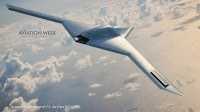 |
| image source |
Aviation Week is reporting that a new stealth drone called the RQ-180 will succeed the now-retired SR-71 Blackbird stealth drone and have a longer range with additional stealth capabilities beyond the current RQ-170.
Northrop Grumman is the beneficiary of taxpayer dollars this go-round.
The drone, funded from the Air Force’s classified budget, was developed by Northrop Grumman aerospace and defense technology company, which won the competition from Boeing and Lockheed Martin.
The company apparently began working on RQ-180 in 2008 when it revealed a $2 billion increase in its order portfolio, the magazine claimed.
The new unmanned aerial vehicle is currently performing test flights at the Area 51 in Nevada known as most secure known operating base of the US Air Force, Aviation Week said.
Both the Air Force and Northrop Grumman refused to comment on the secret project when they were asked by journalists.
[…]
The new drone is similar in size to the Northrop Grumman RQ-4 Global Hawk non-stealthy unmanned aerial vehicle (UAV), which is currently used in Iraq and Afghanistan, but is likely to retire next year.
The RQ-180 weighs nearly 15 tons and can operate for 24 hours, 1,200 nm from its base, exceeding its smaller predecessor RQ-170, which can stay in the air for five to six hours.
The new drone is seen as key for the shift of US Air Force ISR assets away from ‘permissive’ environments such as Iraq and Afghanistan toward operations in ‘contested’ or ‘denied’ airspace. (Source)
One is left to imagine where this “contested” airspace might be, but with China’s recent imposition of a no-fly zone over a group of Japanese islands sitting atop potential oil reserves, there are some hints. That no-fly zone was subsequently breached without incident, but perhaps there is anticipation of what the future might hold … especially as China continues its own development of war drones amid heated economic warfare that lies on the horizon.
The U.S. seeks to make the RQ-180 operational by 2015, which puts it ahead of the next drone in line for 2018 – the world’s first hypersonic drone being developed by Lockheed Martin.
 The race continues among countries and among their suppliers to lead the way toward the autonomous wars of the future. This is taking place in both air and sea, as myriad unmanned drones are taking flight from research laboratories across the world. Drones have even taken to the high-seas, as navies begin to “build fleets of crewless boats capable of missions on and under the water, according to maritime experts,” as discussed at Military.com. And just yesterday it was announced that to specifically thwart China, tiny drones can be launched from submerged submarines.
The race continues among countries and among their suppliers to lead the way toward the autonomous wars of the future. This is taking place in both air and sea, as myriad unmanned drones are taking flight from research laboratories across the world. Drones have even taken to the high-seas, as navies begin to “build fleets of crewless boats capable of missions on and under the water, according to maritime experts,” as discussed at Military.com. And just yesterday it was announced that to specifically thwart China, tiny drones can be launched from submerged submarines.
It’s all about full spectrum dominance . . . and a race to the finish line.
______________________________________________________________________________
United Nations Launches First Fleet of Surveillance Drones
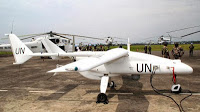 |
| image source |
The latest news shows drones going truly global: the United Nations has launched surveillance “peacekeeping” drones to fly missions above the violence-infested Congo.
The United Nations has launched two drones with plans for more in 2014 that will be used to assist the army in their suppression of rebel groups in DR Congo.
UN peacekeeping chief Herve Ladsous told the BBC that the drones, or “unarmed, unmanned aerial vehicles” would be the “tool of choice” to monitor the activities of armed groups and the movement of civilians.
“We need to get a better picture of what is happening,” he said.
He said that if they were successful in DR Congo, they could also be used in other UN peacekeeping missions. (Source)
This is a flat-out admission of a beta test and a portent to a potential full rollout of UN drones across much of the conflict-ridden planet. It doesn’t take much imagination to foresee how their widespread use could become justified in the wake of increasing criticism of their unilateral use by the United States.
The fact that the first test of U.N. drones should take place in Africa very well could also tie in to the billions of dollars that has been pledged to boost Africa’s infrastructure as globalists prepare the region for corporate expansion. It’s a strategy long in the making, as the former link details.
One has to wonder what might happen if one of these unarmed drones gets shot down. Would weaponization be the next step? Many people in the “conspiracy” circles have always worried about the day that blue-helmeted U.N. troops would arrive to knock on the doors of Americans. The boots on the ground approach might not prove necessary at all. Weaponized U.N. drones patrolling the planet might do the knocking. For now, though, it’s just another conspiracy theory.
________________________________________________________________________
Pakistan Makes Entrance Into Global Drone Arms Race
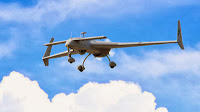 |
| Shahpar surveillance drone image source |
The number of countries with drones has now risen to nearly 90 as Pakistan has now announced its entrance into the global drone arms race with two surveillance drones called Burraq and Shahpar.
The citizens of Pakistan have been outraged of the hundreds of drone bombings by the U.S. that have taken place inside their country in the wake of 9/11. To make matters worse, it was recently announced that the Pakistani government has had a secret pact since at least 2007 that demonstrates complicity in the bombings against their own people. This has all led to 10,000+ Pakistanis taking to the streets to protest.
Now the Pakistani military is claiming the launch of two surveillance drones, which marks a new level of military capability. While the drones are not yet armed, their launch is being hailed as a massive success:
The development of the drones, thought to have a range of about 75 miles, represents a milestone for the country’s military and scientists, Pakistani and Western analysts said.
“It is a landmark and a historic event, wherein a very effective force multiplier has been added to the inventory of the armed forces,” the Pakistani military said in a statement. (Source)
 Regardless of their limited effectiveness compared to the capabilities of those owned by the United States, Israel and Britain, it shows the intent to not be left out of the drone market. It is a market that is expanding across the planet, which ironically (or coincidentally) has the CIA concerned — yes, the very CIA that helped orchestrate the planned bombings in Pakistan with the Pakistani government.
Regardless of their limited effectiveness compared to the capabilities of those owned by the United States, Israel and Britain, it shows the intent to not be left out of the drone market. It is a market that is expanding across the planet, which ironically (or coincidentally) has the CIA concerned — yes, the very CIA that helped orchestrate the planned bombings in Pakistan with the Pakistani government.
More generally, this is most likely another problem-reaction-solution scenario; this time a solution for Pakistan in an attempt to thwart further encroachment by the United States and her allies. In turn, drone development in Pakistan will serve as further justification for the U.S. to deploy their drones inside Pakistan.
It is truly a theater of war, where the military-industrial complex — which is global — continues to orchestrate and manage the various players, while laughing all the way to the bank as they further enslave the citizens of planet Earth.
You can read previous updates below, as China begins to approach the drone capabilities of the United States…
_________________________________________________________________________
China Adds Stealth Combat Drone to Growing Arsenal

China in particular has embraced their use. A report from 2011 indicated that there were at least 280 active drones, and that China was also experimenting with autonomous drone swarms (you can read that story in a previous update posted below). Now Chinese media is announcing the first successful test of a combat-ready stealth drone called “Sharp Sword.”
The new stealth drone goes beyond surveillance capabilities and marks China’s first known weaponized UAV. It has been noted that it could be used in conjunction with China’s first aircraft carrier that went operational in 2012. While not specifically mentioned, this development could mirror the United States’ first successful test of an autonomous drone landing at sea aboard its own aircraft carrier.
The Sharp Sword might be intended for eventual use with the aircraft carrier and for “long endurance” surveillance missions, said Rick Fisher, a senior fellow at the US-based think tank International Assessment and Strategy Center.
“This demonstrates the enormous investment that China is making toward building a world class level of military power,” he said in an email.
This type of aircraft “will greatly complicate the defence” of other countries, including Japan and the US, he added.
[…]
The flight “implies that China has made the leap from drones to combat drones”, it said, calling it the move of “major significance”. (Source)
China’s defense spending is second only to the United States, so it is to be expected that the drone arms race sparked predominately by the United States and Israel will continue to move forward. It is a development that now has the CIA concerned, which you can read from the last update to this post.
_____________________________________________________________________________
CIA Concerned Over Drone Expansion Across the Planet
The Washington Times is now reporting on the further proliferation of drones in countries across the planet. The number has moved from 50 to 87, and apparently has the CIA concerned.
 In what appears to be another classic example of problem-reaction-solution, the very same military-industrial complex that was responsible for encouraging the proliferation of drones is issuing a warning about “rogue” nations getting a hold of the technology. The Washington Times makes a stunningly truthful comment that highlights the irony of the concern:
In what appears to be another classic example of problem-reaction-solution, the very same military-industrial complex that was responsible for encouraging the proliferation of drones is issuing a warning about “rogue” nations getting a hold of the technology. The Washington Times makes a stunningly truthful comment that highlights the irony of the concern:
The U.S., Britain and Israel are the only nations to have fired missiles from remote-controlled drones, but the proliferation of unmanned aerial vehicles has become so prevalent that U.S. intelligence sources and private analysts say it is merely a matter of time before other countries use the technology.
[…]
“Many countries acquired their UAVs from Israel,” said the report.
It said Germany, France, Britain, India, Russia and Georgia have either leased or purchased Israeli drones, including the Heron, a model that many foreign militaries see as a good alternative to the American-made Predators and Reapers.
The Times also highlights that America’s policy of offensive drone strikes, which have killed civilians at a greater rate than supposed terrorists, doesn’t bode well for how other countries are likely to employ their drones. The Times goes on to say that it is China and Iran — the usual suspects — who are the greatest potential threat.
And here is where the solution comes in … more drones, naturally.
Although there is concern in Washington that China will sell the technology to American adversaries, sources say, the U.S. also is pushing ahead with development of its own secretive “next generation” drones.
Today’s models emerged in the post-9/11 era of nonconventional conflict — a time when American use of both weaponized and surveillance-only drones has been almost exclusively over chaotic patches of the planet void of traditional anti-aircraft defenses.
With little or no need to hide, relatively bulky drones such as the MQ-1 Predator dominated the market. But the “big secret,” Mr. Zaloga said, “is that the U.S. is already working on both armed and unarmed UAVs that can operate in defended airspace.”
And develop they are. Recently we have seen the Navy successfully test autonomous drone takeoffs and landings at sea, Boeing has begun to retrofit its decommissioned F-16s into pilotless fighter jets, and solar drones have been developed that can stay aloft for years at a time.
The latest addition to the roster is the proposed hypersonic drone from war profiteer defense contractor Lockheed Martin, which intends to improve upon its SR-71 Blackbird – the fastest production plane ever devised. (source) This drone is capable of flying at Mach 6 (six times the speed of sound, roughly 4,500 mph). The prototype is set to become reality by 2018 and fully operational by 2030; it should fit nicely into the next generation of drones that is is set to transform war, as one can see in a General Atomics video presentation here. Whether or not all systems become a reality, it is clear that investment in permanent war continues unabated.
It is also worth mentioning that as we approach the full-fledged introduction of drones into American skies, as Congress has agreed to by 2015, the selling point to counter any debate about surveillance of citizens might get quashed by this “emerging threat.” They won’t be surveillance drones — they will be a defensive fleet to protect us against the inevitable attack by a rogue nation. And the script continues…
You can read the full report from The Washington Times here:
http://www.washingtontimes.com/news/2013/nov/10/skys-the-limit-for-wide-wild-world-of-drones/?page=1
______________________________________________________________________________
China’s “Drone Swarms” Highlight Global Robotic Warfare Arms Race
Much like nuclear weapons, it seems as though this genie is not likely to find its way back into the bottle. A new report released by Project 2049 Institute reveals that China has taken the rise of the American drone quite seriously and has been investing just as heavily in drone surveillance and weapons capabilities. All indications are that they are quickly catching up to the world’s leader.
According to the report entitled, “The Chinese People’s Liberation Army’s
Unmanned Aerial Vehicle Project: Organizational Capacities and Operational Capabilities,”
China has developed a wide range of unmanned aerial vehicles across all military branches.
 |
| image source |
Domestic competition for military contracts appear to mirror U.S. capabilities:
- Intelligence, surveillance and reconnaissance: electro-optical, synthetic aperture radar (SAR), and signal intelligence (SIGINT) sensors. UAV SIGINT sensors include both communications intelligence and electronic intelligence sensors with a strong emphasis on developing UAVs for locating, tracking and targeting U.S. aircraft carriers in support of long range anti-ship cruise and ballistic missile strikes.
- Precision strike missions. Design concepts include numerous antiradiation and combat type UAVs. During operations they would theoretically be supported by decoy drones whose roles would be to aid in defense penetration by helping to overwhelm and confuse enemy air and missile defenders.28 According to Chinese writings, they would also be supported by electronic warfare UAVs.
- Electronic Warfare Missions: UAVs for jamming satellites, airborne early warning plane communications and radar systems, and ship based early warning, communications, and air and missile defense systems.
- Data Relay Missions. In particular, Chinese researchers note that UAVs could provide a critical link between landbased command and control facilities and anti-ship missiles engaged in long range over-the-horizon attacks. One study also posited that high altitude UAVs equipped with data link payloads could substitute for communications satellites in the event of enemy antisatellite attacks. (Abridged from original report, which can be read in full with citations at the article title link above).
The report further indicates that China already has 280 UAVs in service, and that number is from mid-2011, making it one of the world’s largest fleets. Furthermore, technology “in development” includes autonomous drones swarms:
Chinese strategists have also discussed using swarms of drones to overwhelm the U.S. Navy’s carrier groups in the unlikely possibility of a shooting war. The drones could act as decoys, use electronic warfare to jam communications and radar, guide missile strikes on carriers, fire missiles at U.S. Navy ships or dive into ships like kamikaze robots. (Source)
This capability is very likely to already exist in China, as the “kamikaze robots” have been used successfully by The United States in Afghanistan for at least a couple of years; it’s known as the Switchblade drone.
No one really knows the full level of drone development across the world, due to the obvious secrecy surrounding military technology. The London Guardian has compiled reports of all known drone stocks in the world and offered maps and graphs that illustrate an indication that a drone arms race is fully under way. There are a minimum of 56 drone models used in 11 different countries, with the U.S. leading the pack at 678 operational drones.
A new U.S. study by the Association For Unmanned Vehicle Systems International (AUVSI) shows why drone proliferation continues to ramp up at a nearly exponential rate: it has become one of the fastest growing areas of the U.S. economy. A report entitled, “The Economic Impact of Unmanned Aircraft Integration Systems in the United States” is clear in its conclusion that competition for jobs and tax dollars created by drone tech development is likely to provide the impetus to loosen state regulations on drone use. The AUVSI is projecting 70,000 new jobs in the first three years of full integration.
While we project more than 100,000 new jobs by 2025, states that create favorable regulatory and business environments for the industry and the technology will likely siphon jobs away from states that do not.
The full study can be found at the title link above, but the bullet points as noted by the Association are as follows:
- In the first three years following integration into the NAS, more than 70,000 new jobs will be created.
- In the first three years following integration, the total economic impact stemming from the integration is projected to surpass $13.6 billion and will grow sustainably for the foreseeable future, cumulating in more than $82.1 billion in impact between 2015 and 2025. Economic impact includes the monies that flow to manufacturers and suppliers from the sale of new products as well as the taxes and monies that flow into communities and support the local businesses.
- The study projects integration will lead to 103,776 new jobs nationally by 2025. Many of these jobs are portable and will gravitate toward states with favorable regulatory structures and infrastructure. Future events – such as the establishment of FAA Test Sites – will ultimately determine where many of these new jobs will flow.
- Additional economic benefit will be seen through tax revenue to the states, which will total more than $482 million in the first decade following the integration.
- Every year that integration is delayed, the United States loses more than $10 billion in potential economic impact. This translates to a loss of $27.6 million per day that UAS are not integrated into the NAS. (Source)
Naturally the AUVSI has a vested interest in promoting drone use despite their “non-profit” status. From their About Us page on their website, they don’t hide their goals and connections:
The Association for Unmanned Vehicle Systems International is the world’s largest non-profit organization devoted exclusively to advancing the unmanned systems and robotics community. Serving more than 7,500 members from government organizations, industry and academia, AUVSI is committed to fostering, developing, and promoting unmanned systems and robotic technologies. AUVSI members support defense, civil and commercial sectors.
Mission Statement
Advancing the unmanned systems and robotics community through education, advocacy and leadership.
Vision Statement
To improve humanity by enabling the global use of robotic technology in everyday lives.
AUVSI’s Strategic Goals
- Inclusive Community – AUVSI will be an inclusive and accessible global organization encompassing the robotics/unmanned systems community.
- Global Focus – AUVSI will be the essential partner in the growth and reach of the global robotics/unmanned systems community.
- Education and Outreach – AUVSI will facilitate the expansion of robotics/unmanned systems knowledge and will promote educational opportunities.
- Knowledge Source – AUVSI will be the preferred robotics/unmanned systems knowledge source.
- Advocacy and Influence – There will be recognition of AUVSI by governments, industry and academia as a powerful advocate for robotics/unmanned systems.
- Member Services – AUVSI will provide value-added services to its current and potential membership. (Source)
Despite their stated concern for humanity and desire to foster global economic opportunity, drones and robots are already eliminating many jobs, including military personnel and affiliated tech work. Autonomous intercommunicating systems are being developed by the U.S. and now apparently the Chinese with the capability for unilateral threat assessment and war theater decision making. It is often cited that robotic warfare lessens the dangers to humans, but at some level it becomes an outright replacement, such as DARPA’s amazingly human PETMAN and other warbots. Next generation drones have the stated goal of reducing or eliminating the human element altogether as the promotional video from General Atomics below highlights for 2017.
Similar to the machines in a factory, robots don’t have human frailties such as sickness, tiredness, mental health issues, clouded judgement based on emotions … or conscience. Where do the human resources of war go when they have been outsourced?
It is possible that during the initial phases, it will appear as a boon to the economy, but the cascading effect of a global robotic arms race is likely to reach a tipping point and get out of hand very quickly.
Clearly, even as resistance to drones in American skies heats up, especially following the Rand Paul / Eric Holder debate about the constitutionality of killing Americans on U.S. soil, the military-industrial complex continues to invest in robotic warfare as though global proliferation is a foregone conclusion. The world’s two leading superpowers and the feedback loop they have created ensure it.
______________________________________________________________________________
The Drone Arms Race Heats Up: World’s First “Beach Ball” Surveillance Drone Developed in Japan
Researchers in Japan have provided the latest in all-seeing eye technology: the drone “beach ball”. This might be the clearest evidence yet that we have entered a world which resembles bad science fiction, but, nonetheless, it’s true.
 Homeland Security Newswire reports that the new Spherical Air Vehicle (SAV) “weighs 350 grams (12.3 ounces) and has a diameter of 42 centimeters (16.8 inches); it can reach a speed of 37 miles per hour.”
Homeland Security Newswire reports that the new Spherical Air Vehicle (SAV) “weighs 350 grams (12.3 ounces) and has a diameter of 42 centimeters (16.8 inches); it can reach a speed of 37 miles per hour.”
The developer from the Technical Research and Development Center of the Japan Defense Agency has amazingly constructed this vehicle from parts that can be found at electronics shops for a cost of around $1,400. (Source).
The DIY flying spy camera can bounce, roll, hover and turn corners in any environment using components such as a modified plastic bottle, propeller and control flaps. All operated by remote control. (Source)
Naturally, this has led the researchers to speculate how it can be used in search-and-rescue missions. This is the exact same justification we have heard from military and police sources in the United States to justify the use of micro-drone surveillance over the interior U.S. in violation of the Constitution.
Nonetheless, the technology continues to be developed as competition soars between nations to catch up to the United States. As we wrote about previously, the miniaturization of surveillance and weapons of war is not nearly over. President Obama (signed off on by John P. Holdren) has issued the comprehensive, 60-page National Nanotechnology Initiative 2011 Strategic Plan, calling for investment in nanotechnology to be used in everything from remote sensors for bioweapons detection, to surveillance and traffic control.
The world of science fiction has indeed become our reality. We would be well advised to put pressure on world leaders and the scientific community to use the greatest caution when racing toward a unmanned future that science fiction warns can end rather unpleasantly for the human race.
Here’s the demo (in Japanese)
Updated: 7/22/2014
Nicholas West writes for ActivistPost.com and TechSwarm.com

